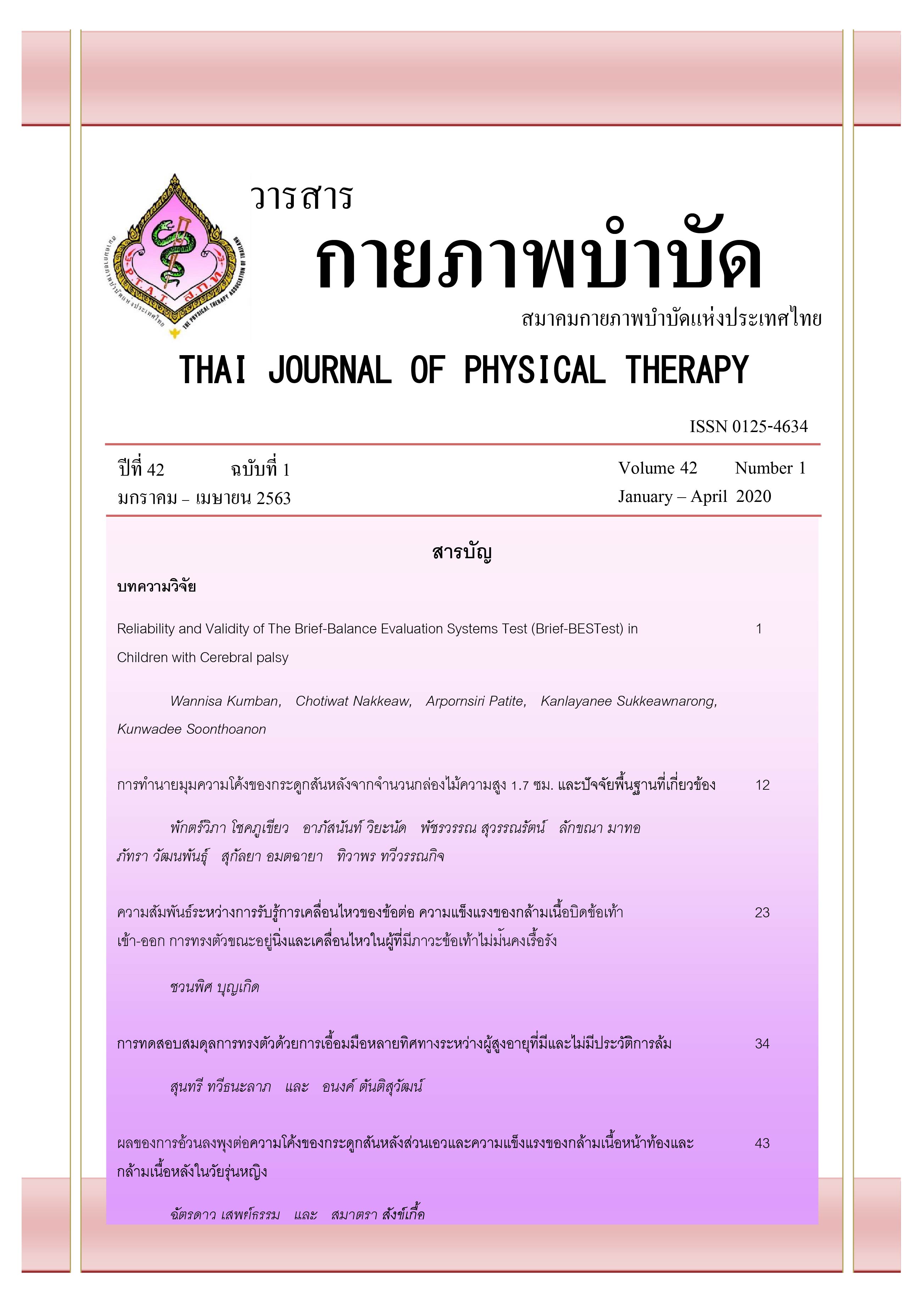การทดสอบสมดุลการทรงตัวด้วยการเอื้อมมือหลายทิศทางระหว่างผู้สูงอายุที่มีและไม่มีประวัติการล้ม
Main Article Content
บทคัดย่อ
ที่มาและความสำคัญ: การล้มเป็นปัญหาที่พบได้บ่อยและเป็นปัญหาสำคัญในผู้สูงอายุ การทดสอบสมดุลการทรงตัวทางคลินิกจึงเป็นสิ่งสำคัญสำหรับการประเมินความเสี่ยงของการล้ม แต่ยังไม่มีการศึกษาขอบเขตการทรงตัวในทิศทางต่างๆในผู้สูงอายุที่มีประวัติการล้ม
วัตถุประสงค์: เพื่อเปรียบเทียบการทรงตัวและการเคลื่อนไหวระหว่างผู้สูงอายุที่มีและไม่มีประวัติการล้ม
วิธีการวิจัย: ผู้เข้าร่วมวิจัยเป็นหญิงที่มีอายุระหว่าง 60-75 ปี จำนวน 60 คน แบ่งออกเป็น 2 กลุ่มตามประวัติการล้ม (กลุ่มมีและไม่มีประวัติการล้ม) การทดสอบสมดุลการทรงตัวทางคลินิกและการทดสอบการทรงตัวขณะเคลื่อนไหวประกอบด้วย การทดสอบสมดุลการทรงตัวด้วยการเอื้อมมือหลายทิศทาง (MDRT), การทดสอบการก้าวเท้าขึ้นลงพื้นต่างระดับ(step test), การทดสอบการทรงตัวขณะเคลื่อนไหว(Time Up and Go test, TUG) โดย MDRT จะถูกทดสอบใน 4 ทิศทาง คือ ทางด้านหน้า ด้านหลัง ด้านซ้าย และด้านขวา การทดสอบการขึ้นลงพื้นต่างระดับโดยนับจำนวนก้าวในการก้าวขึ้นและลงเก้าอี้ในระยะเวลา 15 วินาที และการทดสอบTUG โดยจับเวลาตั้งแต่ลุกขึ้นยืนจากเก้าอี้ที่มีพนักแขน เดินไปข้างหน้า 3 เมตร (ประมาณ 10 ฟุต) เลี้ยวกลับ เดินกลับมาที่เก้าอี้ และนั่งลง
ผลการวิจัย: กลุ่มผู้สูงอายุที่มีประวัติการล้มแสดงค่าการเอื้อมมือต่ำกว่าในทุกทิศทาง (p£0.01) จำนวนการก้าวเท้าน้อยกว่า (p<0.01) และใช้เวลาในการทดสอบการทรงตัวขณะเคลื่อนไหวนานกว่า (p<0.01) กลุ่มผู้สูงอายุที่ไม่มีประวัติการล้ม
สรุปผล: ผู้สูงอายุที่มีประวัติการล้มมีความสามารถทรงตัวในการทดสอบการทรงตัวด้วยการเอื้อมมือหลายทิศทาง การทดสอบการขึ้นลงพื้นต่างระดับ และการทดสอบการทรงตัวขณะเคลื่อนไหวน้อยกว่ากลุ่มผู้ที่ไม่มีประวัติการล้ม จึงสามารถนำแบบประเมินเหล่านี้มาคัดกรองความเสี่ยงในการล้มในผู้สูงอายุ เพื่อที่จะลดการล้มที่เกิดขึ้นในผู้สูงอายุ
Article Details
เอกสารอ้างอิง
Eto F. Causes of falls in the elderly. JMA Journal. 2001;44(7):299-305.
Assantachai P, Praditsuwan R, Chatthanaearee W, Pisalsarakij D, Thamlikitkul V. Risk factors for falls in the Thai elderly in an urban community. J Med Assoc Thai. 2003;86(2):124-30.
O'Loughlin JL, Robitaille Y, Bolvin JF, Suissa S. Incidence of and risk factors and injurious falls among community dwelling elderly. Am J Epidemiol. 1993;137:342-54.
Blake AJ, Morgan K, Bendall MJ, Dallosso H, Ebrahim SB, Arie TH, et al. Falls by elderly people at home. Prevalence and associated factors. Age Ageing. 1988;17(6):365-72.
Lord S, Ward J, Williams P, Anstey K. Physiological factors associated with falls in older community-dwelling women. J Am Geriatr Soc. 1994;42:1110-7.
Lausawatchaikul P, Sirapo-Ngam Y, Putwatana P. Related factors and outcome of falls in the elderly. J Gerontol Geriatr Med. 2000;1(2):16-23.
Cumming RG, Klineberg RJ. Fall frequency and characteristics and the risk of hip fractures. J Am Geriatr Soc 1994;42(7):774-8.
Tinetti ME, Speechley M, Ginter SF. Risk factors for falls among elderly persons living in the community. N Engl J Med. 1988;319(26):1701-7.
Shumway-Cook A, Brauer S, Woollacott M. Predicting the probability for falls in community-dwelling older adults using the timed-up and go test. Phys Ther. 2000;80:896-903.
Pondal M, del Ser T. Normative data and determinants for the Timed "Up and Go" Test in a population-based sample of elderly individuals without gait disturbances. J Geriatr Phys Ther. 2008;31(2):57-63.
Hill K, Bernhardt J, McGann A, Maltese D, Berkovits D. A new test of dynamic standing balance for stroke patients: reliability, validity and comparison with healthy elderly. Physiother Can. 1996;48:257-62.
Duncan PW, Weiner DK, Chandler JM, Studenski SA. Functional Reach: a new clinical measure of balance. J Gerontol Med Sci. 1990;45(6):M192-7.
Podsiadlo D, Richardson S. The timed 'Up and Go': a test of basic functional mobility for frail elderly persons. J Am Geriatr Soc. 1991;39:142-8.
Ng SS, Hui-Chan CW. The Timed Up & Go Test: Its reliability and association with lower-limb impairments and locomotor capacities in people with chronic stroke. Arch Phys Med Rehabil. 2005;86:1641-7.
Steffen TM, Hacker TA, Mollinger L. Age- and gender-related test performance in community-dwelling elderly people: Six-Minute Walk Test, Berg Balance Scale, Timed Up & Go Test, and gait speeds. Phys Ther. 2002;82:128-37.
Berg KO, Maki BE, Williams JI, Holliday PJ, Wood-Dauphinee SL. Clinical and laboratory measures of postural balance in an elderly population. Arch Phys Med Rehabil. 1992;73:1073-80.
Isles RC, Choy NL, Steer M, Nitz J. Normal values of balance tests in women aged 20-80. J Am Geriatr Soc. 2004;52(8):1367-72.
Dite W, Temple VA. A clinical test of stepping and change of direction to identify multiple falling older adults. Arch Phys Med Rehabil. 2002;83:1566-71.
Kwan MM, Lin SI, Chen CH, Close JC, Lord SR. Minimal chair height standing ability is independently associated with falls in Taiwanese older people. Arch Phys Med Rehabil. 2011;92(7):1080-5.
Hill K, Schwarz J, Flicker L, Carroll S. Falls among healthy, community-dwelling, older woman: a prospective study of frequency, circumstances, consequences and prediction accuaracy. Aust N Z J Public Health. 1999;23(1):41-8.
Martins EF, de Menezes LT, de Sousa PH, de Araujo Barbosa PH, Costa AS. Reliability of the Functional Reach Test and the influence of anthropometric characteristics on test results in subjects with hemiparesis. NeuroRehabilitation. 2012;31(2):161-9.
Duncan PW, Studenski SA, Chandler JM, Prescott B. Functional reach: predictive validity in a sample of elderly male veterans. J Gerontol. 1992;47(M93-8).
Cumming RG, Nevitt MC. Non-skeletal determinants of fractures: the potential importance of mechanics of falls. Osteoporosis Int. 1994;4(suppl 1):S67-70.
Newton R. Validity of the Multi-directional reach test: A practical measure for limits of stability in older adults. J Gerontol Med Sci. 2001;56A(4):M248-52.
Tantisuwat A, Chamonchant D, Boonyong S. Multi-directional Reach Test: An investigation of the limits of stability of people aged between 20-79 Years. J Phys Ther Sci. 2014;26(6):877-80.
Gale CR, Cooper C, Sayer AA. Prevalence and risk factors for falls in older men and women: The English longitudinal study of ageing. Age Ageing. 2016;45(6):789-94.
Train the Brain Forum Committee. Thai Mental State Examination (TMSE). Siriraj Hosp Gaz. 1993;45(6):359-74.
Karthikeyan G, Jayraj SJ, Narayana V. Effect of forefoot type on postural stability - A cross sectional comparative study. Int J Sports Phys Ther. 2015;10(2):213-24.
Melzer I, Benjuya N, Kaplanski J, Alexander N. Association between ankle muscle strength and limit of stability in older adults. Age Ageing. 2009;38(1):119-23.
Whitney JC, Lord SR, Close JC. Streamlining assessment and intervention in a falls clinic using the Timed Up and Go Test and Physiological Profile Assessment. Age Ageing. 2005;34(6):567-71.
Jalayondeja C. Falls screening by Timed Up and Go (TUG). J Med Tech Phy Ther. 2014;26(1):5-16.


